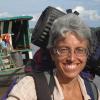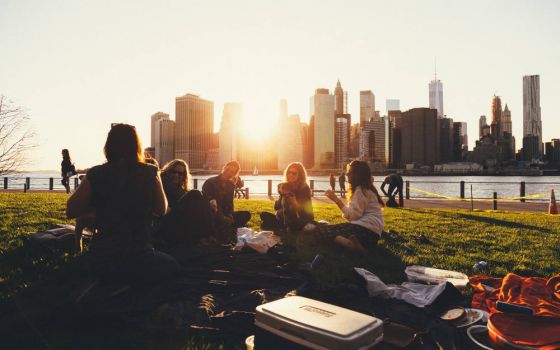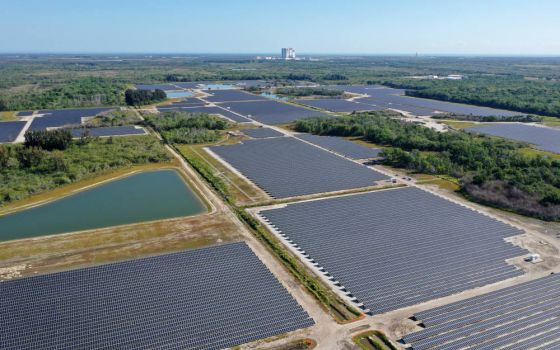
Young people in the Peruvian town of Nauta prepare street paintings made of colored sawdust in preparation for Holy Week processions. (Barbara Fraser)
Editor's Note: EarthBeat Weekly is your weekly newsletter about faith and climate change. Below is the April 2 edition. To receive EarthBeat Weekly in your inbox, sign up here.
Holy Week always reminds me of how radically electricity — something most of us take for granted — can alter people's lives, and why making it clean and affordable is so vital.
When I lived in Peru's Andean highlands nearly three decades ago, the town of Chucuito, on the shore of Lake Titicaca, was known for its elaborate Holy Week processions, which commemorated the Passion of Christ. On Holy Thursday evening, the statue of Mary, Mother of Sorrows, dressed in black, would be carried around one side of the town, while the statue of Jesus would be carried around the other.
They would depart from a small chapel in the lower part of town and meet in the plaza in front of the old colonial church uphill, recreating the meeting of Jesus and his mother on the way to the place of crucifixion. A procession that filled the streets would follow each statue, with people playing wind instruments and drums and singing hymns.
One year in the early 1990s, women were up early on Holy Thursday morning, fetching huge armloads of flowers. They gathered outdoors to adorn the platform that would carry Mary, painstakingly attaching the blossoms along with hundreds of candles.
In the evening, everyone gathered in the chapel to pray before the procession. The candles on the platform bearing the image of Mary were lit one by one. Just a few months earlier, Chucuito had been connected to Peru's power grid, and the platform bearing the image of Christ was lit not by candles, but by four incandescent bulbs plugged into an outlet in the chapel wall.
Men hoisted the platform carrying Mary onto their shoulders and stepped out into the darkness, the candlelight gently illuminating the face of the Sorrowful Mother. Then someone pulled the plug, and the statue of Jesus went dark. There was whispering around me. Would the darkened statue lead the procession?

A view of Lake Titicaca. (William Felipe Seccon/Unsplash)
Outside the chapel, a man waited with a portable generator in a wheelbarrow. He fired up the machine, someone plugged in the lights and the procession continued, with the musicians doing their best to drown out the rumble of the motor.
At the time, only two-thirds of Peru's households had electricity. Now the figure is 97%. The same is true in most of Latin America and Asia, although rural residents are most likely to lack electricity or to have it for only a few hours a day.
Globally, however, inequities remain. Of the estimated 770 million people in the world who lack electricity, 75% live in Africa. And experts say the COVID-19 pandemic has stalled nearly a decade of steady growth in access.
That's a reminder of how closely intertwined energy, health and equity are. While governments have been closing the gap, demand for energy continues to increase, and electricity generation still depends heavily on fossil fuels.
The seventh Sustainable Development Goal calls for clean, affordable energy for all by 2030, a target likely to remain elusive without a sharp shift in investment and subsidies from fossil fuels to renewable sources. This year — with President Joe Biden's international climate conference on Earth Day, April 22, and the U.N. climate summit, COP 26, in Glasgow, Scotland, in November — will show how serious countries are about taking action.
What we've heard from readers this week:
My story this week about the need for both individual conversion and systemic change in efforts to stop global warming drew several reactions.
Sam Mitchell pointed out that the study cited in the story showed "CLEARLY that the single biggest personal lifestyle choice a person can make — BY FAR — is to CHOOSE to have one fewer child." That is true, and it should have been mentioned in the story. The study found that in industrialized countries, having one fewer child has about 20 times the emission-reduction impact as giving up the car, which is the next most significant individual choice.
Besides personal lifestyle changes, the story spoke of the need for people to advocate for climate-friendly public policies, but reader Nikki VanDerGrinten said that is not enough.
Advocacy, she wrote, "should be in conjunction with voting for climate-focused representatives. The third action, promoted by [climate scientist] Katherine Hayhoe, is talking about climate risks with friends and groups on a regular basis. Finally, I would suggest considering divesting from fossil fuels. I agree that taxing the fossil fuel companies is necessary."
She adds: "Have you heard of the Energy Innovation & Carbon Dividend Act (HR763)? Please do explore all that it proposes, including a dividend that would be equally distributed to every household on a monthly basis. This approach would incentivize [research and development] of alternative energy while providing $$ for the poor to counterbalance the rise in utility bills." A more detailed explanation of the bipartisan bill, which has drawn support from the U.S. bishops, can be found here.
We welcome your thoughts about the stories published on EarthBeat. You can write us at earthbeat@ncronline.org.
Here's what else is new on EarthBeat this week:
- Peter Feuerherd reports that the Passionist retreat house in New York City is undergoing extensive renovation and will reopen next year with a renewed ministry offering an environmental and social response to the cries of both the poor and the Earth — reflecting the influence of Passionist Fr. Thomas Berry.
- Speaking at an online conference sponsored by St. John's University, a top U.N. official said the Earth doesn't need saving — we do, writes NCR environment correspondent Brian Roewe. Satya Tripathi, head of the U.N. Environment Program's New York office, said that "Mother Nature will go on," regardless of what happens to humans.
- "The mystery of resurrection is first of all the constant and universal pattern, which is then made dramatic, daring and trustful in the personal body of Jesus," writes Fr. Richard Rohr in "Soul Seeing for Lent." He adds, "Science is now helping us to think this way."
- Pierre Cochez of La Croix International reports on a coffee farmer in the Mexican state of Chiapas, who follows in the footsteps of his deacon-father by teaching Sunday catechism classes in his mountain village.
- Climate change and environmental destruction are forcing millions from their homes, and Catholics have a responsibility to assist them, Pope Francis wrote in the preface to a new document, "Pastoral Orientations on Climate Displaced People." Cindy Wooden has the story for Catholic News Service.
- Good Friday brings EarthBeat's "A Climate-Conscious Lent" series to a close, with Fr. Emmet Farrell reflecting this week on the globalization of indifference, the leading role being taken by students and the call to stewardship.
Advertisement
Here's some of what's new in other climate news:
- The White House announced the names of 26 environmental leaders and activists from around the country who will make up the Council on Environmental Quality's Environmental Justice Advisory Council, reports Kelsey Brugger at E&E News. They include Texas professor Robert Bullard; LaTricea Adams, CEO of Black Millennials 4 Flint; and Indigenous rights activist Jade Begay.
- Victoria Guida at Politico reports that U.S. Treasury Secretary Janet Yellen called climate change an "existential threat" and a major emerging risk to the country's financial system. Meanwhile, at the World Bank, a policy revision calls for bringing financing into line with climate goals, but stops short of pledging to stop funding fossil fuels, write Valerie Volcovici, Andrea Shalal and Kate Abnett for Reuters.
- Dino Grandoni at The Washington Post reports that dozens of outside experts appointed under the Trump administration will be dismissed from the U.S. Environmental Protection Agency in an effort to put science back in the forefront of environmental policy and reduce the influence of industry.
- And Justin Worland at Time looks at the various ways in which Biden's $2 trillion infrastructure plan, announced March 31, addresses climate change.
Upcoming events:
Interfaith Power & Light will mark 20 years of a religious response to global warming with a virtual celebration April 7 at 5 p.m. Pacific Time. The event will include music, stories, and a message from Bishop Michael Curry, presiding bishop of the Episcopal Church.
You can find more information about this and other upcoming events on the EarthBeat Events page.
Closing beat:
The coronavirus pandemic is an ongoing reminder of the inequities that persist between and within countries, and of how dependent we are on healthy ecosystems for survival. In the same way, may Easter remind us of the role we must play in restoring our broken world.
We at EarthBeat wish you and those you love a blessed Triduum and a joyful Easter.
If you like EarthBeat Weekly, please share it with a friend. Feel free to pass along the link to EarthBeat Weekly on our website. Or if you prefer, you can sign up here to receive the newsletter in your inbox every Friday. Thank you for reading EarthBeat!






